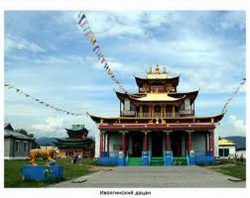Buriats - Religion and Expressive Culture
Religious Beliefs and Practices.
The traditional religion of the Buriats is shamanism. In the middle of the seventeenth century the first Buddhist missionaries from Mongolia and Tibet appeared in Buriat encampments. The feudal aristocracy accepted Buddhism and began the construction of the first monasteries.
In 1741 the Russian Empress Elizabeth issued a degree recognizing the Buriats as Buddhists and affirming the eleven monasteries ( datsan ) and 150 lamas living in them. In 1991 the Buriats commemorated the 250th anniversary of this official recognition of Buddhism in Russia.
The Buriats practiced the Buddhism of the Gelygpa school, which originated in Tibet in the beginning of the fifteenth century and constituted a synthesis of Mahayana and Theravada. Toward the beginning of the twentieth century, forty-seven monasteries were active on Buriat land, the largest of which were considered to be Gusinoozersk (Tamchinsk), Tsongol'sk, and Aga.
They had printing shops and printed religious and secular literature, medical and astrological works, didactic works for adults, and books for children. They even formed a national school of Buddhist iconography and sculpture. Along with Buddhist monasteries, Russian Orthodox and even Evangelical missions existed.
Religious practice in Buriatia represents its own synthesis of Buddhism, shamanism, and Orthodoxy, as well as cults of nature (earth; sky; fire; "spirits" of mountains, rivers, lakes, etc.), a syncretism that to some degree is preserved today.
In the late 1930s the Buddhist culture of the Buriats was crushed. Monasteries were destroyed. Some of the masterpieces of monastery art were given to museums. Others were destroyed. In the last few years Buddhism has been revived. Twelve monasteries are now open and functioning.
Arts. The art of the Buriat people is multifaceted. It includes the heroic epic Abai-Geser, related to analogous Tibetan and Mongolian epics, and folklore of small genres (such as fairy tales, proverbs, riddles, and greetings).
Metalworking, including forging of metal, coining in silver, and the making of knives and decorative plates for men's belts, goes back to ancient times. Local jewelers made beautiful adornments for women such as rings, bracelets, trim for headdresses, and pendants for braids out of silver, turquoise, coral, and pearl.
Leather from domestic animals was used to make bags, vessels of various sizes, footwear, and clothes, all adorned with stamped ornamentation. Like all nomads of the Eurasian Steppe, the Buriats made wooden wares such as dishes for eating, storing of flour and salt, and cooking meat.
However, Buddhist wooden sculpture (especially the characters of the pantheon and historic figures who contributed to the development of Buddhism in Buriatia) seems to have no analogy in the art of other cultures.
